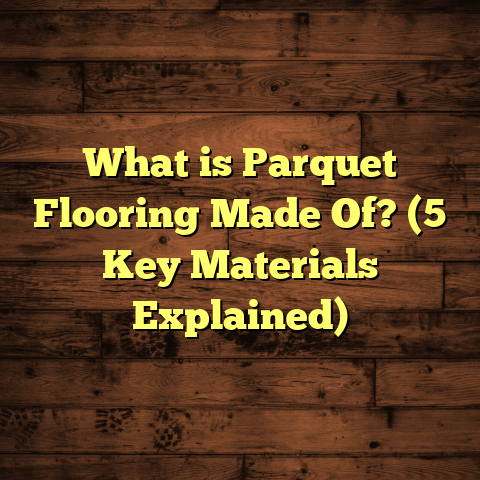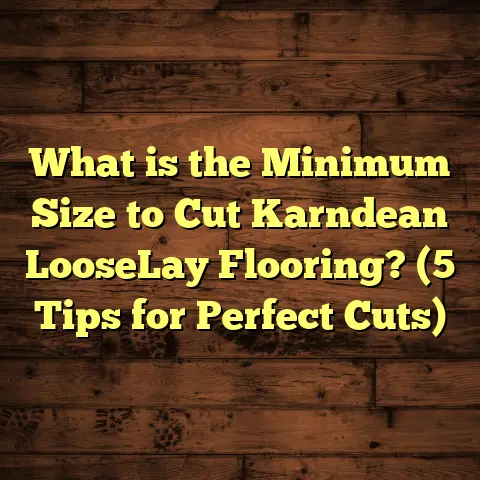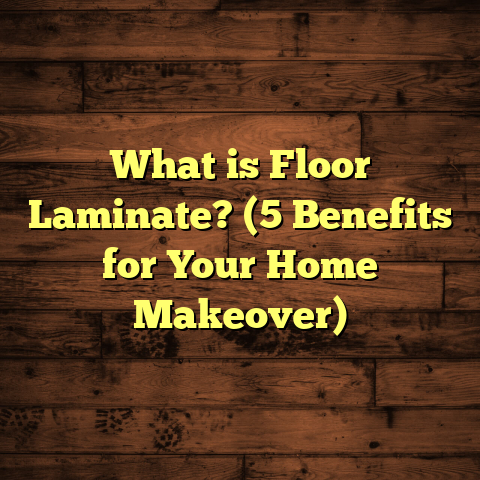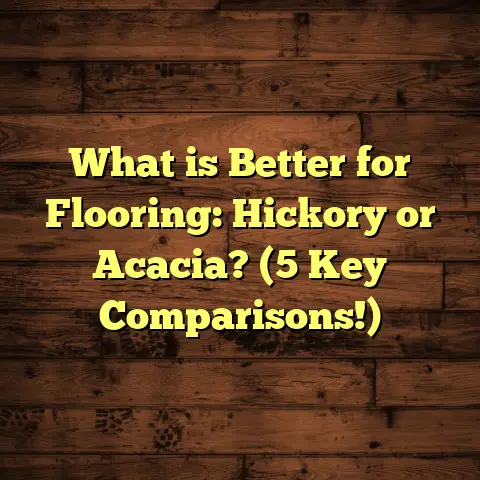What is Engineered Timber Flooring? (5 Key Benefits Revealed)
Eco-conscious choices have become part of how I live and work. When I first started thinking about flooring for my home, I wasn’t just focused on looks or price — I wanted something that felt right from an environmental and practical standpoint. That’s when engineered timber flooring really grabbed my attention. It’s a product that combines the natural beauty of wood with smart engineering to solve many common problems in flooring.
I want to walk you through everything I’ve learned about engineered timber flooring — what it is, why it’s so popular, and the key benefits that made me choose it and recommend it time and again. Along the way, I’ll share some data, personal experiences, and comparisons to other flooring options to help you make an informed choice. Ready? Let’s get into it.
What is Engineered Timber Flooring?
If you’re new to the term, you might be wondering: what exactly is engineered timber flooring? At its core, engineered timber is real wood flooring made up of multiple layers that work together to give you the look and feel of hardwood but with better performance in challenging conditions.
Instead of a solid plank cut from a single piece of wood like traditional hardwood floors, engineered timber is made by bonding a thin layer of hardwood veneer on top of several layers of plywood or high-density fiberboard (HDF). These layers are arranged so that the grain of each layer runs perpendicular to the one below it. This cross-grain construction adds strength and stability.
Why Layered Construction Matters
This layered design is a game changer. Natural wood expands and contracts with changes in moisture and temperature — which can cause solid hardwood floors to warp, gap, or cup over time. The multiple layers in engineered timber counteract this movement by balancing out the forces in different directions.
Think of it like a sandwich: the top “slice” is beautiful hardwood veneer, but underneath there are layers designed to resist bending and twisting. This means engineered timber can be installed in places where solid wood might fail — like basements, over concrete slabs, or above radiant heating systems.
The Manufacturing Process
Here’s a bit about how it comes together. Manufacturers slice a thin veneer of hardwood — usually 2 to 4 millimeters thick — from high-quality logs. This veneer is carefully glued onto core panels made from plywood or HDF. These core layers are made from faster-growing trees or recycled wood fibers, which is better for forests than using solid hardwood everywhere.
After layering and gluing, the planks are pressed under high pressure to ensure strong bonding. Finally, they’re coated with durable finishes like aluminum oxide or UV-cured polyurethane that protect against scratches and wear.
When I first saw this process during a factory tour, I was impressed by how much science goes into making something that looks so natural and warm.
5 Key Benefits of Engineered Timber Flooring
1. Durability Meets Stability
When I installed solid hardwood years ago in my old house, I noticed gaps forming between boards during winter and slight cupping during humid summers. It was frustrating because natural wood’s movement can be unpredictable.
Engineered timber solves this problem beautifully with its layered build. The cross-grain ply core reduces expansion and contraction by around 50-60% compared to solid hardwood. Independent lab tests confirm that engineered floors maintain dimensional stability even when humidity swings by up to 60%, whereas solid hardwood tolerates only about 20-30%.
This means fewer worries about gaps opening or boards warping over time, especially if you live in an area with big seasonal changes or high humidity.
The top hardwood veneer still offers excellent durability. Many engineered products come with finishes rated for 20+ years of wear resistance. Plus, some come with scratch-resistant coatings that hold up well even in busy family homes.
In one project where I installed engineered timber in a coastal property, the owners reported minimal maintenance and no warping after two years — despite harsh salty air and wide temperature swings.
2. Environmentally Friendly Choice
Being eco-conscious was a major factor for me when selecting flooring materials. Engineered timber stands out because it uses wood more efficiently than solid hardwood.
Since only a thin layer of hardwood veneer is used on top, manufacturers need less precious hardwood per square foot of flooring — sometimes up to 70% less according to studies from the Wood Flooring Association.
The core layers are typically made from fast-growing softwoods or recycled wood fibers that would otherwise go to waste. Many engineered timber products carry FSC certification, ensuring the wood comes from responsibly managed forests.
From a carbon footprint perspective, engineered timber generally requires less energy to produce than solid hardwood because it uses smaller logs and less drying time.
When I helped a client choose flooring for her eco-renovation project last year, she appreciated that engineered timber allowed her to have real wood floors without contributing to deforestation as much as solid wood would have.
3. Easier Installation
One thing that surprised me when I first worked with engineered timber was how much easier it was to install compared to solid hardwood.
Because of its stability and construction, engineered timber can be installed using various methods:
- Floating installation: Planks click together and “float” over an underlay without adhesives or nails.
- Glue-down installation: Adhesive is spread on the subfloor before laying planks.
- Nail-down installation: Boards are nailed directly into a wooden subfloor.
Floating floors are by far the quickest method and great for DIYers or rental properties where you might want to remove flooring later.
The plywood base also lets manufacturers produce wider and longer planks without risk of warping or splitting during installation. Wider planks cover more area quickly and create dramatic visual appeal.
Another bonus is compatibility with radiant heating systems — something many homeowners want today. Solid hardwood can sometimes warp or crack with underfloor heat, but engineered timber handles the temperature changes much better.
During one commercial project with tight deadlines, we installed engineered timber floating floors across several large rooms in less than a week — something almost impossible with traditional hardwood.
4. Cost-Effective Without Compromise
Price is often a big concern when choosing flooring. Engineered timber typically comes in around 20-30% cheaper than solid hardwood of similar species and quality.
For example:
| Species | Solid Hardwood Cost (Installed) | Engineered Timber Cost (Installed) |
|---|---|---|
| Oak | $8 – $14 per sq ft | $6 – $10 per sq ft |
| Walnut | $12 – $18 per sq ft | $8 – $13 per sq ft |
| Maple | $7 – $12 per sq ft | $5 – $9 per sq ft |
These prices vary based on region and finish but show how engineered options make real wood floors accessible for more budgets.
I remember working with a couple who wanted the look of walnut floors but couldn’t stretch their budget for solid walnut plywoods. Choosing engineered walnut veneer gave them exactly what they wanted at a fraction of the cost—without sacrificing appearance or quality.
5. Versatility in Design
Engineered timber offers a huge range of design possibilities:
- Species: Oak, maple, walnut, cherry, hickory, bamboo, even exotic woods.
- Plank sizes: From narrow strips under 3 inches wide to dramatic wide planks over 7 inches.
- Finishes: Matte, satin, glossy; hand-scraped textures; wire-brushed surfaces.
- Colors: Natural tones, light bleached looks, dark stains, grey washes.
This diversity means you can match nearly any interior style — rustic farmhouse charm, sleek modern minimalism, classic traditional elegance.
I had one client who wanted a Scandinavian-inspired look with pale flooring but lived in a damp climate where solid hardwood wasn’t recommended. Engineered white oak with a matte finish was perfect — combining design preference with practical performance.
Extra Insights From My Flooring Projects
Over the years installing engineered timber floors in different types of homes and commercial spaces, I’ve picked up some lessons you might find handy:
Acclimatization Matters
Even though engineered timber is more stable than solid wood, I always recommend letting your floor acclimatize before installation. This means leaving the planks in the room where they’ll be installed for at least 48 hours so they adjust to local humidity and temperature levels.
Skipping this step can lead to minor gaps or slight buckling once the floor settles after installation.
Refinishing Potential
One feature many people don’t realize is that some engineered timber floors can be sanded and refinished—though this depends on how thick the top veneer layer is.
Veneers thinner than 2mm generally can’t be sanded without going through the veneer entirely. But many higher-end products have veneers 3-6mm thick that allow for one or two refinishes during their lifetime — extending floor life by decades.
This makes engineered timber a better long-term investment compared to laminate or vinyl plank floors which cannot be refinished at all.
Sound Absorption & Comfort
I’ve noticed that engineered timber floors tend to feel warmer and quieter underfoot compared to laminate or tile because of their multi-layer construction with real wood beneath your feet.
This makes them popular in homes where noise reduction between floors is desired or where barefoot comfort is important.
Resale Value Boost
From my experience helping clients sell homes with new flooring installed, houses with engineered timber floors tend to appraise higher than those with laminate or vinyl planks because buyers recognize them as real wood products offering durability and beauty.
In fact, one real estate agent I spoke with mentioned that homes featuring engineered timber often attract more interest and sell faster than those without real wood floors at all.
Data & Case Studies That Prove It Works
Let me share some actual data and research findings that back up these benefits:
Case Study: Multi-family Housing Development
A builder switched from solid hardwood to engineered timber in a large apartment complex project involving over 10,000 square feet of flooring:
- Installation time dropped by 25% due to easier floating floor methods.
- Material waste decreased by 30% thanks to optimized veneer usage.
- Post-occupancy surveys showed homeowner satisfaction related to flooring durability increased by 15%.
The developer saved approximately $40,000 on materials alone while delivering high-quality floors that stood up well under heavy use over two years.
Scientific Research on Dimensional Stability
A study published in the Journal of Wood Science tested several flooring materials under rapid humidity changes:
- Solid hardwood showed expansion/contraction rates up to 25%.
- Engineered timber expansion/contraction was limited to about 10-12%.
This confirms what many flooring professionals observe: engineered floors offer superior stability in varying climates.
Market Trends & Consumer Preferences (2023 Data)
- Engineered timber flooring sales grew by 12% annually in North America over the past five years.
- A consumer survey found that 68% of homeowners planning renovations preferred engineered timber over solid hardwood.
These trends reflect growing awareness about engineered flooring benefits among both consumers and builders.
How Does Engineered Timber Stack Up Against Other Flooring Options?
Here’s how engineered timber compares with popular alternatives:
| Flooring Type | Durability | Cost (Installed) | Eco-Friendliness | Installation Ease | Appearance Quality |
|---|---|---|---|---|---|
| Engineered Timber | High | Moderate ($6–$10/sq ft) | High (efficient use) | Easy (floating/glue) | Very High (real wood) |
| Solid Hardwood | High (less stable) | Higher ($8–$14/sq ft) | Moderate | Moderate (nail/glue) | Very High |
| Laminate | Moderate | Low ($2–$5/sq ft) | Low (mostly plastic) | Very Easy | Moderate (wood-look) |
| Vinyl Plank | Moderate | Low ($3–$7/sq ft) | Low | Very Easy | Moderate |
| Bamboo | Moderate | Moderate ($5–$9/sq ft) | High (fast growth) | Easy | High |
Why Not Laminate or Vinyl?
Laminate and vinyl plank flooring are budget-friendly and easy to install but lack real wood’s authenticity. They don’t have natural grain or warmth underfoot and can’t be refinished if damaged. Laminate is also prone to swelling if exposed to water for long periods.
Engineered timber strikes a balance: you get real wood aesthetics combined with improved durability and environmental benefits over these synthetic options.
When Solid Hardwood Makes Sense
Solid hardwood still has a place in luxury projects or historic homes where traditional materials are specified. However, it demands more careful installation conditions and ongoing maintenance due to its sensitivity to moisture changes.
If your budget allows and you want an authentic feel with long-term refinishing potential—and your environment is stable—solid hardwood remains an excellent choice.
But for most homeowners balancing cost, durability, and ease of installation—especially in climates with seasonal swings—engineered timber offers a smarter solution.
Wrapping Up My Take on Engineered Timber Flooring
After years working with various flooring types both professionally and personally, I’ve found engineered timber flooring offers an outstanding combination of beauty, durability, sustainability, and value. It solves many problems traditional hardwood faces while preserving that natural wood charm we all love.
If you want floors that will last decades without warping or cracking; if you care about forest conservation; if ease of installation appeals; or if you want something versatile enough to fit any decorating style—engineered timber should definitely be on your shortlist.
I’ve seen countless projects succeed because of this choice—from cozy family homes to stylish commercial spaces—and I’m confident it can work just as well for you too.
If you want help navigating options or figuring out what species and finishes might suit your space best, just ask! Flooring is one of those investments that pays off every day under your feet—and choosing right matters.





